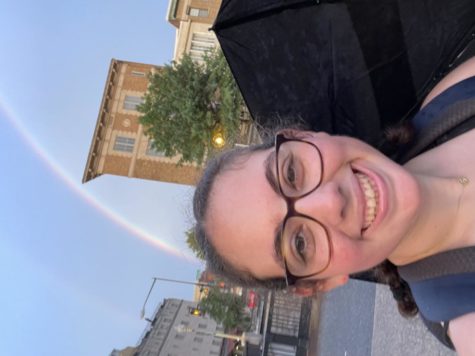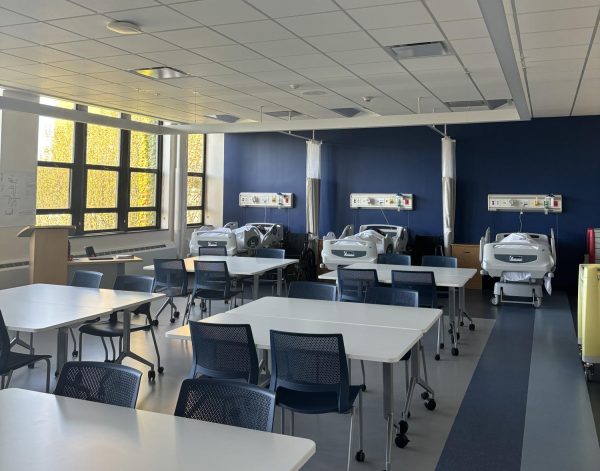Predominantly white advocacy group for reopening sees success
Restrictions under a hybrid model create a far cry from a standard school experience.
March 22, 2021
As the summer of 2020 began to wind down, both District 65 and District 202 had yet to announce their plans for the coming school year. The uncertainty over remote versus in-person learning left some parents feeling out of the loop with the decisions that the school administrations were making in regards to their children’s learning and health. The result of this growing concern among parents was the creation of Reopen Evanston Schools (RES).
With the adoption of the hybrid model in both Districts 65 and 202, it seems that RES has made headway in its fight to fully return to in-person learning. However, the clamor for reopening was far louder among white families than with families of color, something seen in the reopening demographics.
After ETHS families made their selections for hybrid or remote learning, data showed that of the 1,720 students returning, 67 percent are white, 12 percent are Latino and 11 percent are Black. These numbers can be contrasted with the total school population which is 46 percent white, 25 percent are Black and 20 percent are Latino. In total, 67 percent of white students opted to return to hybrid compared to 29 percent of Latino students and only 20 percent of Black students. About half of all Asian students and those students who identify as having two or more races opted in, with 52.7 and 51.4 opting in respectfully.
This disparity between white students and students of other races comes as no surprise given the racial make-up of RES, which has been led by and for white families. Of the 127 signatories to the first list of demands issued to District 202, 93 percent were white, the Evanstonian found. As RES has grown, with the group now touting over 500 members, the racial makeup of the group on the whole may be different than that of the 127 signatories that are listed on the RES website.
RES first formed in the late summer as schools started releasing their plans for the coming school year, plans which predominantly featured remote options.
“It was actually at the end of the summer, I believe, trying to reach out to the [District 65 and District 202] administrations, sending latest science and evidence in the data, saying things are starting to look pretty good and coalesce around reopening of schools,” Kai Sternstein, a member of RES, said. “We have a physician who is an emergency medicine physician at the children’s hospital downtown who is very concerned about what she was seeing in terms of admissions and emergency-room mental health visits that were starting to escalate at a very rapid level.”
Currently, the organization includes over 500 members, comprised of parents, physicians and mental health professionals, many but not all of whom live in Evanston and have children attending D65 or D202 schools.
On July 17, ETHS announced their fall reopening plan, which consisted of a remote start followed by hybrid learning. However, parents involved in RES remained frustrated with the lack of transparency regarding the decisions made by the school board and administration. RES raised questions about what science administrators were looking at and how their students’ well-being would be impacted.
“We’ve been frustrated over the summer. Parents who loosely knew each other were writing letters [to the school administrations] but not hearing back, and that was sort of my frustration when the hybrid plan was put out in July and then reversed. That instigated a certain group of frustration, and we saw that pattern continuing to the fall,” Laurel O’Sullivan, a RES member, recalled. “We have such an educated group of resources available in this community. It’s a huge job to reopen a school, so we would like to, as Evanston parents, try to help. We really wanted to have an open dialogue, and the frustration got greater because that offer was not accepted.”
Shortly after ETHS announced their fall plans, the choice to transition to hybrid was revoked, with the administration announcing the implementation of complete remote learning instead.
With this shift, RES gained more traction among parents and health-care professionals in the Evanston community. With the goal of getting schools to reopen and allow students some semblance of normalcy with learning, RES members have been vocal in their advocacy efforts in multiple capacities. In addition to their online presence with their Facebook group, RES members have written letters and spoken at both District 65 and District 202 school board meetings.
In early 2021, as the most prominent reopening group in Evanston, RES succeeded in getting District 65 schools to reopen for hybrid learning beginning on Feb 16.
However, some members of RES did reach out to state representatives in hopes of receiving support for a push to reopen all Evanston schools, not just District 65.
“We thought reaching out to members of the General Assembly might be helpful, and we met with them, and we talked to them, and I don’t want to speak for them, but, I mean, we were just constituents,” Eric Herman, a RES member, said.
Until recently, RES had been less successful with the ETHS administration, who have been adamant in its decision to remain completely remote until the recent announcement of a hybrid learning opportunity.
On March 1, Superintendent Eric Witherspoon announced that ETHS would be offering a hybrid learning choice for students beginning April 15. RES has stated it had no role in the decision to offer a hybrid learning option and that the decision was made by the ETHS administration.
“We always pay attention to our public input, whatever it’s about and whatever people are advocating for or against. The communications that we have received have probably been about as balanced as anything, but for every person who feels one way about this, there’s another one who feels the other way about it…. I think that people [making decisions] need to factor in all those different points of view. We’ve definitely been factoring them in, and we get ideas about something that might be a concern that we could incorporate or an idea of something that we can watch out for that we don’t do in a bad way…. Ultimately, I make the decisions based on all the factors that I know, because I have so much more information,” Superintendent Eric Witherspoon said in a March 1 interview with the Evanstonian.
“We’ve had no role in crafting or having any input on the hybrid plan. We’ve offered, through our physician’s group, to give the district advice, consulting services, input, because we have a lot of qualified people [in the physician’s group] who can provide advice. To date, that advice has not been welcomed or asked for. That is what our role has been—strictly one of advocacy,” Herman said.
With respect to ETHS’s decision at the beginning of the school year announcing the enhanced e-learning plan and its willingness to stay the course throughout the year, most ETHS staff and teachers have supported the administration’s decision to remain remote.
“Our ETHS students aren’t going to benefit from the hybrid model and will, in fact, be harmed by it. I agree with Dr. Witherspoon in the 12/18 E-Town Live when he said, ‘We’ve come to understand that, if in-person is the best, the second-best is to actually be on remote, which we’ve been on, and the third-best is the hybrid model.’ I can’t imagine why he would say that and then make the unilateral decision that he’s just made,” a letter submitted to the March 8 school board meeting by a group of 13 teachers states.
Despite ETHS’s recent announcement regarding hybrid learning in response to the push to reopen, some community members and teachers remain opposed, many of whom attribute the success of RES to their privilege. Though denied by some members of RES, the organization is predominantly comprised of white and affluent Evanstonians.
“That premise [of RES members predominantly being white and affluent] is a false premise; it is false,” Herman said in a Zoom interview with the Evanstonian. Continuing in a follow-up email, he added, “Some false information about our group has been circulated on Facebook, and in one instance someone posted a ‘study’ along the lines you described. It did not paint an accurate picture of our group.”
An anonymous satirical letter released in late-January questioned the motives and equity lens of the group. “The 127 rowdy citizens were 93 [percent] melanin deficient… Only [five] of the assignees had home values below the area median [of $391K], and the median of the rabble-rousers landed at a whopping $676K.” While the Evanstonian could not verify this claim, it could verify the claim, as previously stated, that 93 percent of members listed on the RES website—the initial 127 named signatories—are white.
“[RES has] shown that they’re just as organized as the parent groups in other districts; they are not a group unique to us. I don’t even think it’s just all Evanston people. I think it’s a group of folk who have signed up to advocate that Evanston schools reopen, even if they live in another place. I do believe that there are a lot of Evanston residents that are a part of that, but I also think that, listening to some of the rhetoric from the board meeting, that doesn’t sound like an Evanston person,” Principal Marcus Campbell said in a March 17 interview with the Evanstonian.
For Evanston residents and ETHS staff members who remain opposed to hybrid learning, RES’s ability to sway both the ETHS administration and school board is yet another example of inequitable racial dynamics in Evanston. As COVID-19 ravages communities of color in a way that predominantly white communities haven’t felt or experienced, some individuals argue that reopening demonstrates a level of indifference towards students and staff that have suffered immense amounts of loss in the last year.
“I remain incredibly concerned for the research and data that shows how transmission and diagnosis of COVID-19 has had and will have on our Black and Brown and elderly populations if we open in-person prematurely,” English teacher Angela Sangha-Gadsden said in a letter submitted to the administration at the March 8 school board meeting.
“This hybrid model will put Black and Latino students and employees at greater risk for contracting this disease…. It is important that as a community we acknowledge the racial disparity that exists for this disease and do what is best for the entire community. In this decision, there should be strong consideration for the health and safety of our Black and Latino families. ETHS promotes equity for all students and families, however, this decision supports those with the most privilege,” English teacher Deshana Newman wrote to the school board.
“There’s an effort to pressure schools to reopen for kids, although we know who’s dying of COVID[-19] at disproportionate rates, we know who was exposed at a disproportionate rate, we know who lives in multiple generational households,” Campbell said.
“I am sure your Black and Brown staff members and students would like to attend school in person, but they want to live more. Melanated people need you to center their humanity as you plan to reopen the schools,” Jasmine Sebaggala wrote in a letter submitted to the March 8 board meeting.
Additionally, RES admits that, when referring to students who would like to return to the ETHS building, they are often speaking of their own children rather than speaking of empirical data collected from students across Evanston. No such survey had been conducted on behalf of RES or ETHS prior to the hybrid preference form released on March 2.
“We’ve said that we’ve all been talking to our kids and their friends and so forth, and [what we’re] saying didn’t necessarily ring untrue, although there’s definitely some ambivalence [about it],” O’Sullivan said.
“There are real issues and barriers to reaching a lot of families and a lot of students,” Sternstein said.
Although there was a fall survey conducted by ETHS for students, parents and staff, the results may not represent the way students feel about e-learning almost seven months later and did not ask about the question of returning to in-person school. Since that initial survey, ETHS has not conducted a follow-up survey for students.
Despite the announcement of hybrid learning, RES remains committed to ensuring a full reopening for all students, as stated in a letter to the school board on March 8.
“On behalf of our 500 members, the Reopen Evanston Schools coalition is encouraged by ETHS’s recent announcement that hybrid learning will begin on April 15. While this is a necessary and positive step, however, it is not enough… More must be done to ensure that kids’ needs are being met, that the community understands ETHS’s decision-making processes and that ETHS is moving toward providing full-day, in-person classes, five days a week.”
Editor’s Note, Mar. 22, 11:22 a.m.: This article has been updated to include all of the pertinent racial demographic categories ETHS provided with regards to hybrid opt-ins. The overall demographic numbers are pulled from Illinois Report Card.



















